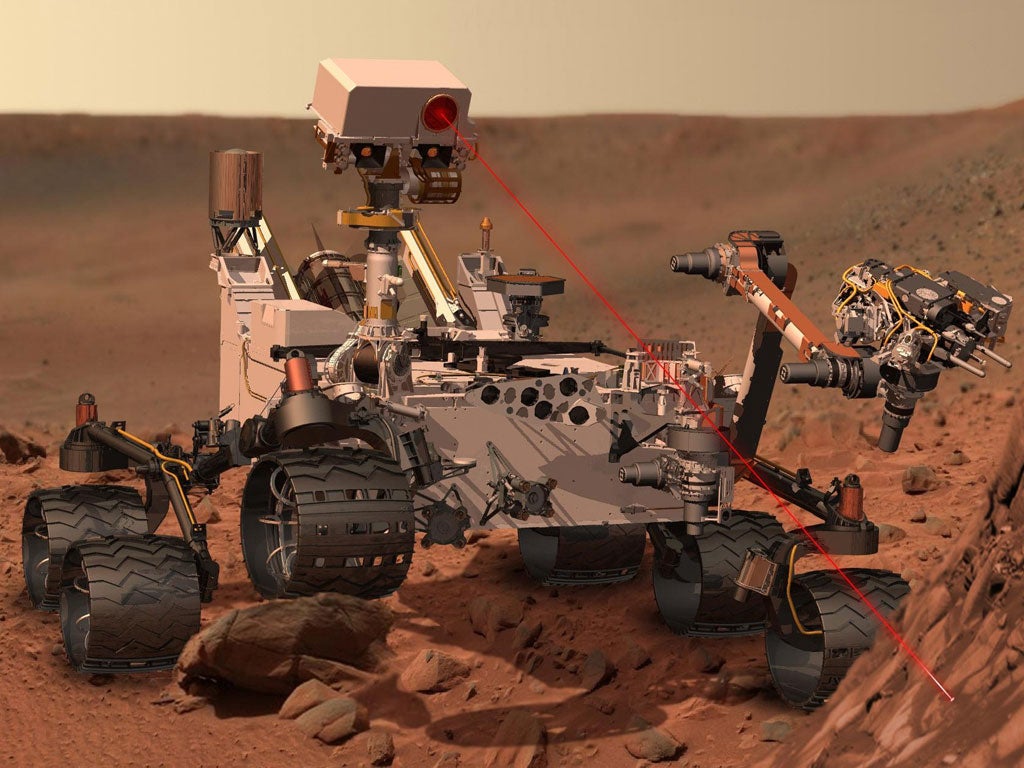Nasa's seven minutes of terror to land Curiosity rover in mission to explore Mars

Your support helps us to tell the story
From reproductive rights to climate change to Big Tech, The Independent is on the ground when the story is developing. Whether it's investigating the financials of Elon Musk's pro-Trump PAC or producing our latest documentary, 'The A Word', which shines a light on the American women fighting for reproductive rights, we know how important it is to parse out the facts from the messaging.
At such a critical moment in US history, we need reporters on the ground. Your donation allows us to keep sending journalists to speak to both sides of the story.
The Independent is trusted by Americans across the entire political spectrum. And unlike many other quality news outlets, we choose not to lock Americans out of our reporting and analysis with paywalls. We believe quality journalism should be available to everyone, paid for by those who can afford it.
Your support makes all the difference.They call it the seven minutes of terror, and for good reason, as this is the perilously short length of time Nasa scientists have given themselves to land a space probe on Mars that will hit the Martian upper atmosphere at 13,200mph.
On Monday morning, a few seconds after 6.30am London time if all goes to plan, Nasa will know whether a $2.5bn (£1.67bn) gamble on a heat shield, a set of eight retrorockets and three nylon lines has paid off.
For the first time, a landing vehicle will be gently lowered to the surface of another planet using nylon tethers suspended from a mother spacecraft hovering precariously overhead.
A safe landing will be the culmination of a hair-raising journey through the thin Martian atmosphere which will have begun seven minutes earlier as Nasa's Mars Science Laboratory mission begins its entry and descent to the surface of the Red Planet.
During the "guided entry" phase small thrusters on the back of the spacecraft will adjust the angle and direction of movement, enabling the probe to make sweeping S-shaped turns that will help it to slow it down.
More than ninth-tenths of the deceleration will result from the intense friction generated between the spacecraft's heat shield and atmosphere, which will raise temperatures on the outside of the shield to 2,100C.
A 15.5m-wide parachute will be deployed about 254 seconds after entry, at an altitude of about seven miles and a velocity of some 900mph. This will slow the craft down to about 280mph, when the heat shield is jettisoned and video cameras and retrorockets begin to take control of the final few minutes of the descent.
The retro-engines are designed to slow the probe down to about 1.7mph when, just 20m above the surface of the planet, a "sky crane" will gently lower Curiosity, a six-wheeled rover vehicle the size of a Mini Cooper, on the three nylon tethers, a manoeuvre lasting about 12 seconds.
On touchdown, the mother craft above will cut the tethers and fly off to crash land well away from the landing site so as not to interfere with Curiosity's bank of scientific instruments designed to analyse Martian geology and search for fossilised signs of life.
Charles Elachi, director of Nasa's Jet Propulsion Laboratory, is under no allusion about the difficulty of the landing mission, which he said was equivalent to controlling the energy of 25 high-speed trains at full speed.
"That's the amount of energy we have to dissipate in six minutes so that we can land softly on the surface," Dr Elachi said on a recent visit to London.
"The accuracy we have to point to be at the right angle is equivalent to me being in Los Angeles and hitting a golf ball to land in a hole on St Andrew's golf course in Scotland," he said.
Previous landings
Viking 1 and 2 (1975): successful orbiters and landers that took the first detailed images and soil samples.
Mars Global Surveyor (1997): provided high-res images from orbit and the surface.
Mars Pathfinder (1997): the first successful airbag landing of a six-wheeled rover.
Mars Climate Orbiter (1998): lost a year later due to a conversion error bringing it too close to the planet.
Mars Express and Beagle 2 (2003): successfully entered orbit but its lander disappeared.
Mars Exploration Rover Opportunity (2004): still roving.
Mars Reconnaissance Orbiter (2006): powerful camera and spectrometer looking for water.
Join our commenting forum
Join thought-provoking conversations, follow other Independent readers and see their replies
Comments